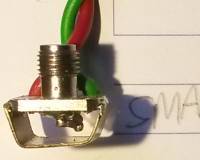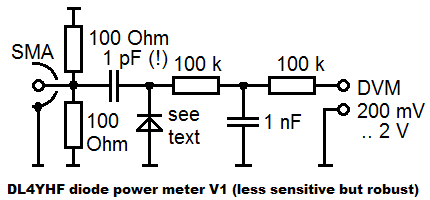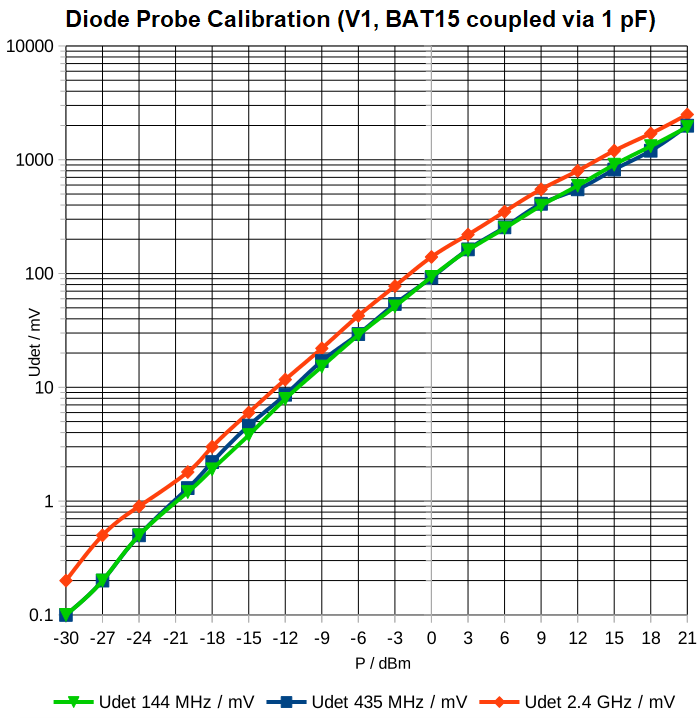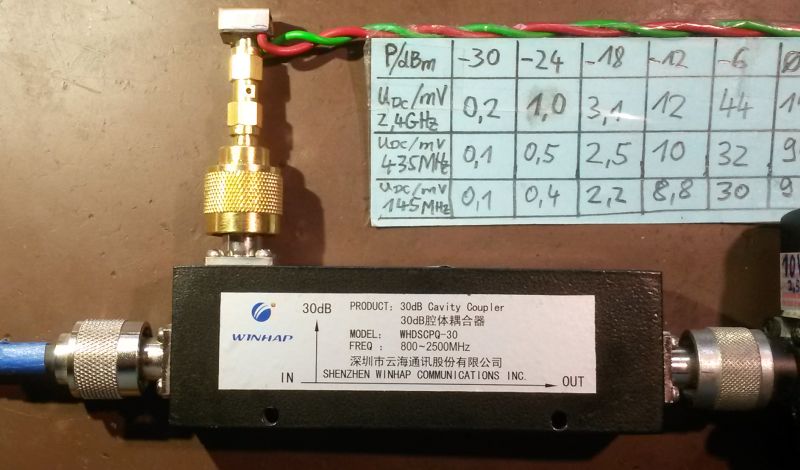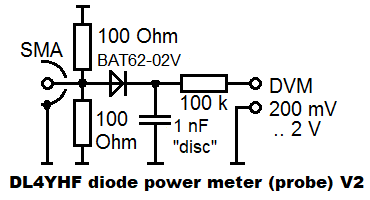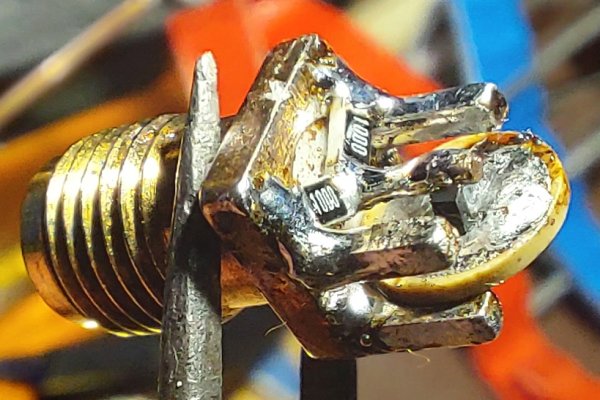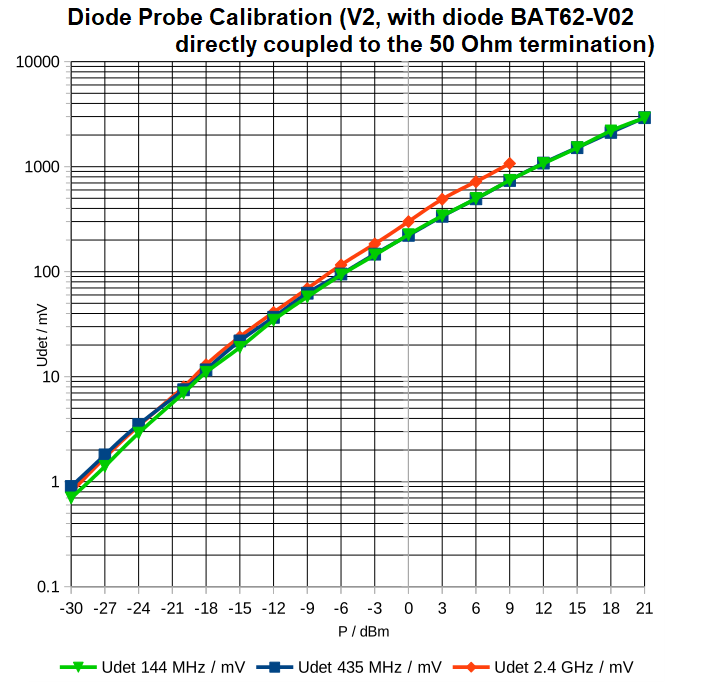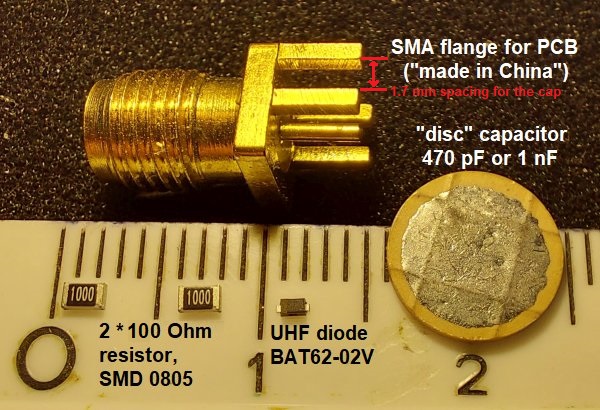Diode power meter with 50 Ohm termination for VHF and UHF (144 MHz to 2.4 GHz)by Wolfgang Buescher, DL4YHF last updated: January 2023. |
|
This document describes the construction of a very simple diode power meter
for low signal levels (between -30 and +20 dBm). It is used in combination with
a cheap chinese wideband 'Cavity Coupler' to measure output powers on 2.4 GHz, and
reverse power without having to carry around a heavy professional power meter.
Since the author's last BAT62 decided to drop onto the carpet (where it vanished into dust), an old BAT 45 with up to 1.1 pF at zero bias was used in in the 'V1' circuit shown above. The 1 pF input coupling capacitor (used in 'V1' but not in 'V2') effectively forms a capacitive voltage divider with the diode's junction capacity. Thus, the 'V1' circuit is a bit more robust (because the diode isn't connected directly to the RF source), but less sensitive than in the simplified circuit 'V2' presented further below. The LibreOffice 'Calc' file for circuit 'V1' can be downloaded from here, so you can replace the measured detector voltages in columns 'Udet 144 MHz', 'Udet 435 MHz', 'Udet 2.4 GHz' (the column titles should speak for themselves). When printed, the entire spreadsheet looks like this (PDF), including the diagram of detector voltage ("Udet" in millivolts) versus RF power (in dBm):
On this occasion: The Chinese directional coupler shown above, with a specified frequency range of 800 to 2500 MHz, can also be used on lower frequencies (with lower coupling of course, but you can take this into account since it's easy to measure). The author's 'WINHAP WHDSCPQ-30' (= coupler with nominal 30 dB 'forward' coupling between 800 and 2500 MHz) delivered on the "30 dB" port... With the coupler reversed (3.16 Watts into the "OUT" port, and a questionable 50 Ohm dummyload on the "IN" port), the diode power meter indicated 2 mV "reverse" (= ca. -20 dBm) on the coupler's "30 dB" output. On 2.4 GHz, the "power dummyload" possibly wasn't good enough to check the coupler's directivity (which should have been greater than the measured 25 dB). Simplified version of the 'detector head' : V2 with BAT62-0V, directly coupledIn January, a second diode power meter was built (V2, with the circuit shown below). This time, with a BAT62-02V diode coupled directly to the 2 * 100 Ohm (in parallel 50 Ohm "dummyload") SMD chip resistors, directly soldered to an SMA flange.
Calibration table for this particular probe (as PDF for printing, and ODS for editing): Kalibrierung_Diodenmesskopf_BAT63-02V_2023_01.pdf / Kalibrierung_Diodenmesskopf_BAT63-02V_2023_01.ods .
Due to the lack of a 'capacitive voltage divider' between 50 Ohm terminator and diode, V2 is more sensitive, and give reproducable results even if the individual junction capacity ("typical 0.35 pF, maximum 0.6 pF") varies.
Deriving a formula to convert 'DC millivolt' readings into dBm with a pocket calculatorHaving to look up the 'dBm' (decibel over milliwatt) from a table, or a half-logarithmic diagram as shown above in this document is ok, and for many applications, sufficiently accurate.But a simple numeric expression to directly convert the measured DC voltage into RF milliwatts, or dBm, would be handy. If we had an ideal diode, this would be trivial because But at 0.01 mW = -20 dBm, an ideal diode rectifier (or "peak voltage detector") would deliver sqrt( 0.01 mW * 50 Ohm ) = 22.3 mV; that's much more than the 8 mV DC measured with a BAT62-02V. Obviously (but as expected), at these low voltages, even a 'low barrier Schottky diode' like the BAT62 is not an 'ideal' diode. A formula to convert directly from "measured DC millivolts" into "RF milliwatts" or dBm can only be derived from the 'calibration points' shown in the tables above (0.8 to 1073 mV DC between -30 and +20 dBm). At the time of this writing (January 2023), the author had tried a few online curve-fitting utilities to derive a simple formula (suitable for pocket caluclators), but the results were neither simple nor accurate. Experiments with 'interactive curve-fitting' are still in an early stage of development ... to be continued...
|
back to DL4YHF's main ham radio homepage
|
